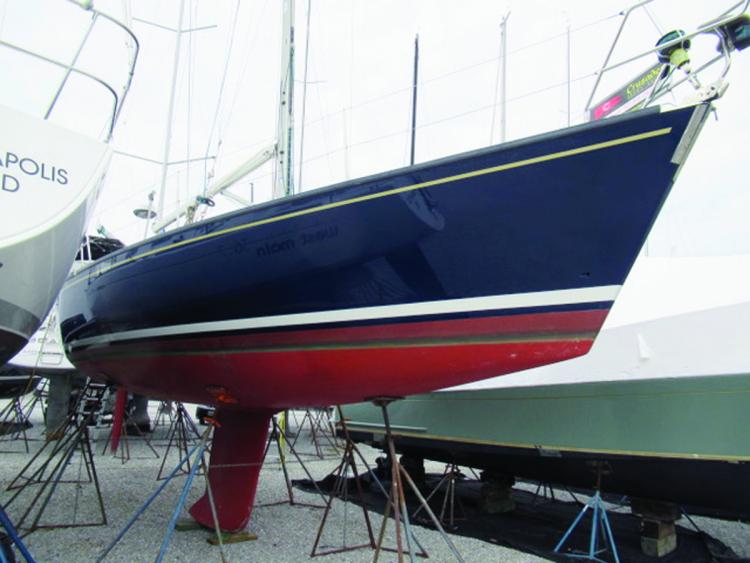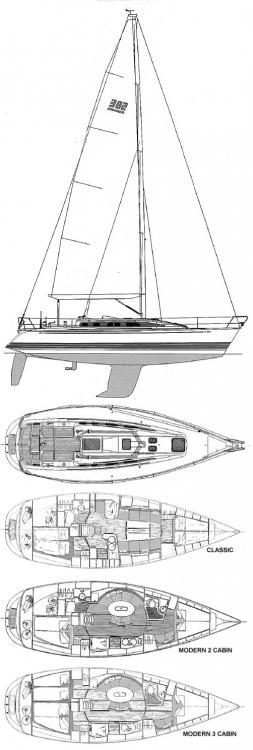Performance Sailing on the X-Yachts X-382
The lion’s share of the new and brokerage sailboat sales in the United States could be divided up between a handful of well-known popular builders. There are many overseas builders that never seem to achieve a consistent foothold in the North American sailing market, either by choice or circumstance. One builder that has often been overlooked in this “fringe” is X-Yachts.

The X-Yacht presence in the US market has always been small when compared to the domestic and overseas giants. While many brands suffer from poor marketing or misplaced manufacture support, X-Yachts quality, design, and dealer network has remained consistent. I believe its limited presence in North America is more due to its price point, which is in my opinion justifiably higher than some other European Brands. I have seen several brands change local dealers multiple times; X-Yachts seems to value quality representation and service without having to resort to what appears to be “knee jerk” shifting of dealers. In short, X-Yachts is a quality manufacturer with a consistent and reliable domestic dealer network.
X-Yachts, a brief history
X-Yachts is a European boat builder based in Haderslev, Denmark. The company was founded in 1979 by the Brothers Niels and Lars Jeppesen and Birger Hansen. In 2012, majority ownership shifted to Ib Kunoe. The original founders, the Jeppesen Brothers and Hansen, are still involved with day-to-day operations and remain responsible for design and production. All X-Yacht designs to date have been designed by Niels Jeppesen. The primary focus from the start has been on performance sailing resulting in several internationally competitive designs over the years. X-Yachts has produced around 5000 boats. In the early 1990s, the global desire for racer-cruiser designs led to the introduction of the X-412 and the X-382. The emphasis on the racer-cruiser designs remains focused on performance first, cruising amenities second.
X-382
The 382 was one of the first of the racer-cruiser designs offered by X-Yachts. Production of the 382 ran from 1995 to 2003 with 141 hulls built. The 382 was offered in three interior layouts, starting with the “classic” layout with a starboard aft galley and standard centerline folding saloon table and V-berth. The modern two-cabin version included a portside saloon settee, offset table, and starboard midship galley. The “modern three cabin” version was the same as the modern two-cabin but with a third berth under the port cockpit seat.
The interior woodwork has a distinctive “Scandinavian” feel (which some of us affectionately refer to as “Ikea” boat interiors). The original design draft of the 382 was almost seven feet, which for a North American 38-footer was a little thirsty. A redesign of the keel and rudder in 1999 offered a five-foot, 58-inch draft version of the 382.

Construction and systems
All systems design and components are to CE (Conformité Européen) requirements. In the world of yacht building this includes strictly reviewed and approved stability thresholds and CE approved design and installation of all electrical and mechanical systems. All components used in building and outfitting of CE certified yachts need to be CE approved—right down to the light bulbs.
Keel Grid: One of the X-Yacht Innovations was the 1981 introduction of the steel bilge grid system. To my knowledge this system is used on all X-Yachts built since then. The system allows an efficient addition of rigidity and strength that would require a significantly higher volume of fiberglass to achieve. The keel is bolted through the hull directly into the spine of the steel frame creating an almost bulletproof system for supporting, distributing, and integrating the mast step and keel loads. Using steel in this fashion is not unique to X-Yacht; what is unique is the long-term use of steel and resisting the change to more exotic building methods or materials.
The engine is a three-cylinder Yanmar auxiliary coupled to a Yanmar SD 20 Sail Drive. Both have excellent track records for reliability.
The mast is a triple-spreader, keel-stepped, aluminum one with stainless steel rod rigging and a roller furler genoa. Many racer-cruisers of this size will have a double spreader rig.
Hulls were built with fiberglass skins and Divinycell core with solid fiberglass in high load areas such as the keel sump, rudder post, engine stringers, and chain-plate gussets.
The modern two-cabin version was built with two heads, which in my opinion was/is a waste of valuable interior space in a 38-footer; the modern three-cabin version has only one head, which in my mind is counterintuitive, but at some point you simply run out of room.
Findings and observations
The steel grid work in the bilge is hot-dipped-galvanized, which has proven to be acceptably resistant to rust and corrosion. When buying any used boat pay attention to any steel components. Rust is analogous to a tear in a favorite piece of clothing or equipment; once it starts, it’s essential to secure it quickly to prevent spreading. Despite claims to the contrary, at some point in the boat’s life, rust is going to be a factor. With that said, the last one I inspected was 21 years old and looked almost new.
Rod rigging has long been a standard in many performance boat designs; the downside is that it is almost impossible to inspect during the course of a normal yacht survey. Rod replacement is often determined more by age as opposed to actual condition.
The electrical system from the factory is European in design and among other things lacking any GFCI protection. This is easy to rectify. AC and DC electrical wiring color coding is not 100-percent compatible with ABYC recommendations.
Marketplace
As of March 2021, there are no 382s on the market. Domestic sold prices seemed to vary from $45,000 (a donated sail training boat) to $114,000.
About the Author: Capt. Tarn Kelsey owns and operates Kelsey Marine Survey in Annapolis.




